We are artists!
This afternoon, we created our final print as part of our art topic. We had already created a background using tissue paper. We only used primary colours and overlaid the pieces to create different shapes as well as different colours. Inspired by Castle and Sun by Paul Klee, we created a design for our polystyrene sheets and then drew the design carefully on.
Today we rolled out our ink and precisely rolled the ink onto our polystyrene design. Then we pressed the design down onto our tissue paper background and rolled it flat with a dry roller. Finally, it was the moment to reveal what we had created. We were so happy with our final pieces, I think they all look amazing! I love the changes of colour, shape and pattern the children have made. Unfortunately, I was a little busy (and inky!) to capture photos of the process! However, I have included a photo of everybody’s final piece, they should all be very proud of themselves!

Help at home by talking to your child about their own piece of art and how they created it.
Maths – 2-D shapes
This week in Maths we learnt all about 2-D shapes. We learnt the names and properties of simple 2-D shapes and different ways we can sort them. Mr McGriffiths tried to trick by turning the shapes around and making them bigger and smaller but we were not fooled. We know that if a shape has 3 sides and 3 corners then it must be a triangle!

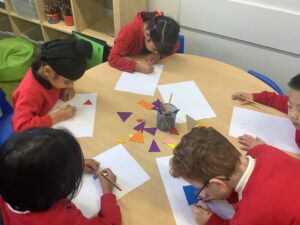

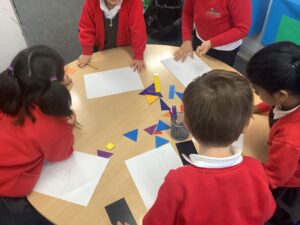
We also drew round the shapes to make different pictures on paper. This shape work carried on in our art this week where we used tissue paper shapes to create a background for our prints. We are very excited to see how they will turn out!
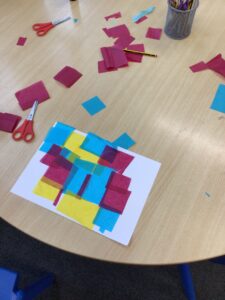
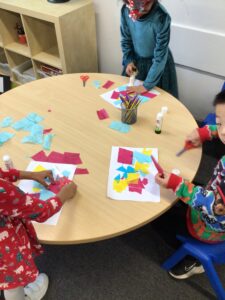
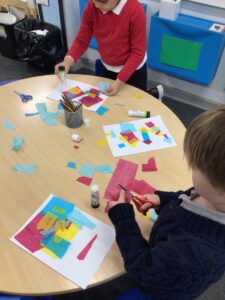
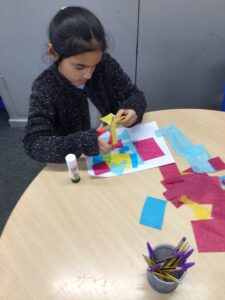
Help at home by spotting 2-D shapes at home.
DT food – banana sandwich
On Tuesday this week we headed over to the kitchen to make banana sandwiches. This is part of our DT food curriculum and the children will be making two further recipes over the course of the year.
First we had to choose our bread.

Then we chopped and slice our banana using the claw and bridge grip.



Next we spread cream cheese on our bread.
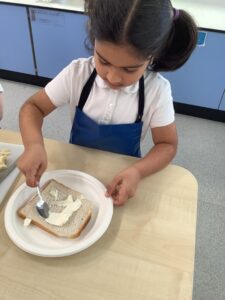

After that we arranged our bananas on top and sprinkled on some cinnamon.

Finally we ate it! It was delicious!
Help at home by talking about the cooking and maybe trying some cooking of your own at home.
Art – The Hepworth Gallery
Last Thursday, we had an amazing time at the Hepworth Gallery in Wakefield. The children loved the gallery and were in awe of the size of not only the sculptures but the gallery itself. In the morning the children took part in a workshop where they explored parts of the gallery and drew some of the sculptures they liked. Then, they took their ideas back to the workshop room and did some printing. The children were so engaged and listened excellently to the workshop leader.
In the afternoon, we explored the gallery ourselves in small groups. The children were so excited and enthusiastic to examine the art and complete some careful drawings. Again they were extremely well behaved and a member of the public commented how well they had done!







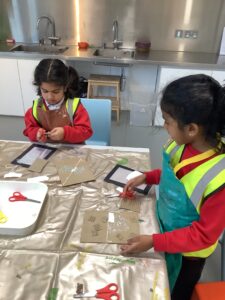




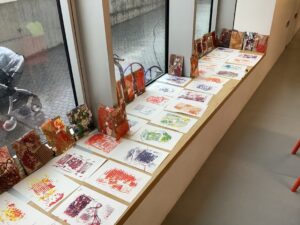

Help at home by talking about the trip and exploring their artwork that they have brought home on Friday.
Living and Learning: new school charity
Every year, we vote for a new school charity to support and this week is the start of the selection process.
Our new charity will replace our current school charity St Gemma’s Hospice. An amazing £1500 has been raised for this great, local cause.

Whole school homework this week is to consider the following shortlist of charities.
The Children’s Heart Surgery Fund
The main objective of the charity is to enhance the quality of care and support available to babies, young children and adult congenital cardiac patients, who are treated at the Leeds Congenital Heart Unit, based at Leeds General Infirmary. https://www.chsf.org.uk
Zarach
We receive referrals through our network of schools. We deliver a bed bundle for every child in the household that requires it; this includes a brand-new Bed, Mattress, Duvet, Pillow, Bed Sheets, Pyjamas and Hygiene Kit. We work with local partners to include Food Parcels and, if needed, a school uniform. We can also mediate between families and their support services, as well as making referrals. https://zarach.org/
Leeds Hospitals Charity
To further any charitable purpose or purposes relating to the general or any specific purposes of Leeds Teaching Hospital Trust or the purposes of the National Health Service. https://www.leedshospitalscharity.org.uk
Simon on the Streets
Objectives are to: 1) prevent and relieve hardship and need and distress amongst those who are homeless and rootless by the provision of practical and emotional support, in particular but not exclusively to those who are sleeping rough or who are unwilling or unable to accept existing provision; 2) educate the public concerning the problems of social isolation and homelessness. https://simononthestreets.co.uk/
Trussell Trust
The Trussell Trust supports a nationwide network of food banks and together we provide emergency food and support to people locked in poverty, and campaign for change to end the need for food banks in the UK. www.trusselltrust.org
Mind (The National Association for Mental Health)
We provide information and support, campaign to improve policy and attitudes and, in partnership with independent local Minds, develop and provide local services. https://www.mind.org.uk/
The charities will be reviewed in class on Thursday 23 November. Each class will vote for one charity which will be brought to the Junior Leadership Team who will have the final vote on Friday 24 November.
Author visit – James Mayhew
Today we were very lucky to have a zoom call with James Mayhew. He is author and illustrator of the Katie books, where Katie goes on magical adventures through art galleries. He spoke passionately about he love of drawing, art and writing and explained to us how he became an author. It all started with a trip to the museums in London!
He then told us all about the process of creating a book and how much time, effort and editing goes into the process. He also told us some stories whilst drawing and colouring the pictures, it was very impressive and the children were enthralled.




We got the chance James some questions and learn more about his favourite artists, favourite books and how long it takes to complete a book!
Help at home by talking to your child about the visit and looking out for any books by James Mayhew in the library or at home!
Living and Learning: Anti-bullying day
Today we had anti-bullying day at school. We all came in odd socks to show that everyone is different and everyone is unique.

The whole day was dedicated to us learning all about what bullying was and how we could stop it.
We started off anti-bullying day by thinking about what makes a good friend. We had some brilliant ideas.

We spoke about what bullying means and looked at the JLT’s definition of bullying. We know that is has to be several times on purpose.

We spoke about what we need to do if we are being bullied or if we see someone being bullied. We learnt that we need to start telling other people. We wrote down someone people we could tell on handprints.

We read the story #Goldilocks, where we learnt about how to treat people online. We know that we treat people the same face-to-face and online.

Help at home by talkinf about the differences between falling out and bullying, and between a one-off situation and something that’s happened more than once
Living and Learning: Me and My Money week
This learning forms part of our Living and Learning curriculum.
We learnt all about different aspects of money: where it comes from, how we use it and where it is kept.
What money do we use?
People from the bank came to visit us and spoke to us all about different kinds of coins and notes. They also spoke to us about the history of money and how it has been changed over time.

Why should we keep our money?
We spoke in class about where is best to keep our money so it is safe. Lots of us had a money box or a piggy bank – some even had a unicorn bank! We discussed how when we grow up we will keep our money in a bank so it is safe.
What is the difference between needs and wants?


Year 1 and 2 worked together to learn what is a need and what is a want. We thought deeply about some of the items and where they fitted in.
Clothes are a need but if you already have lots of clothes they become a want.
The internet is a need as some people have to work from home.

How do people use money?
People make different choices with their money. We talked about how some people spend their money, some save it and some people donate it.
I want to save my money in my moneybox so I get get something big.
I like to spend my money straight away!
I want to spend my money so that the person it goes to has money for what they want.
At Moortown, we donated some money this week. On Monday, Steph from St Gemma’s Hospice, our current school charity, shared how our donations of £1500 have helped the hospice.

This week, we’ve been donating money to St Gemma’s Hospice by bringing any spare 1ps and 2ps to make a penny trail at the end of the week.

Where does my money come from?
We thought about where our money might come from and how that would change as we get older and have a job. Lots of us got money for doing jobs around the house or when we lost a tooth!

Help at home: discuss this learning with your child at home to consider how they use money and why money is important.
Living and Learning: anti-bullying day and odd socks day
On Monday, all children will be learning about bullying and how to STOP bullying as part of the national antibullying week.
Our Junior Leadership Team have recently reviewed our bullying definition. As part of this, we use two STOP acronyms: Several Times On Purpose Start Telling Other People – one’s a definition of bullying and the other’s a solution.

On Monday, we will also be taking part in Odd Socks Day which celebrates that we’re all unique. Children are invited to wear odd socks to school, marking the fact we’re all different in some way.
Odd socks day sends an important message to pupils that they should be allowed to be themselves, free from bullying. It helps us celebrate anti-bullying day in a fun and positive way.
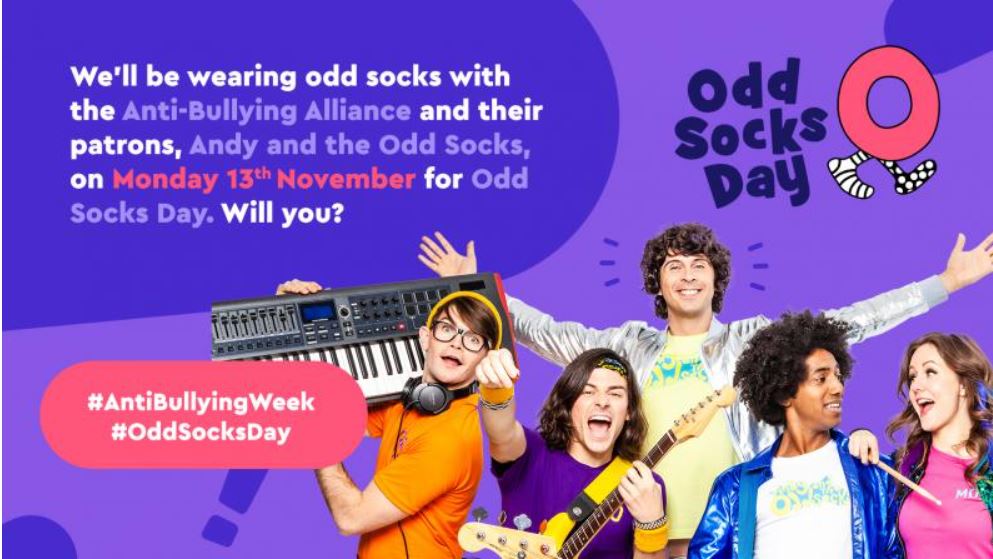
Help at home: Talk about our school definition of bullying and the differences between falling out and bullying, and between a one-off situation and something that’s happened more than once.
Me and My Money week – school charity donations
Donating money is one choice people might make when using their money.
As part of our Me and My Money themed week, we welcomed visitors from St Gemma’s Hospice, our current school charity, to hear how they have been using our donations over this year.
We have raised a staggering £1500 across the year so thank you for all of these donations. St Gemma’s Hospice are very grateful for this support.
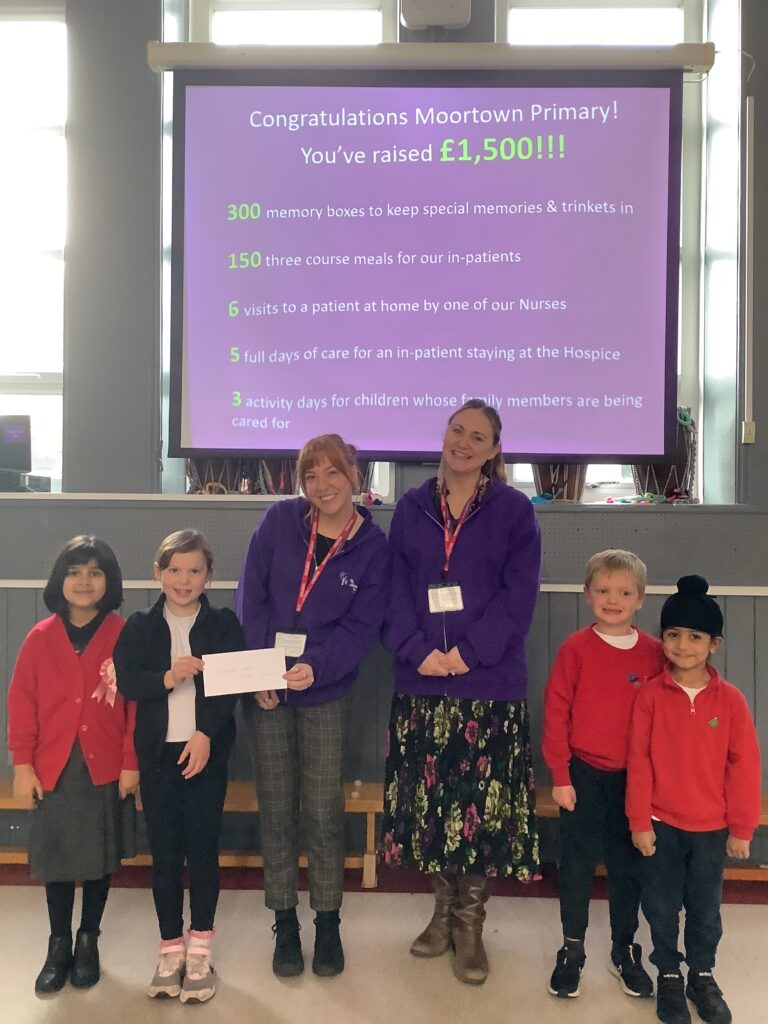
There is one more way we can donate money this week and this is by bringing any spare 1ps or 2ps into class to deposit in each class’ saving jar.

On Friday, we shall be having a money trail with all the coins donated so please bring any spare change before then.
Here are Year 2 counting their coins so far.
